Phase-Change Material Thermal Energy Storage for the Smart Retrofitting of Existing Buildings
Abstract
:1. Introduction
- The obligation to install solar panels on new public and commercial buildings and new residential buildings;
- Doubling the rate of deployment of heat pumps, and measures to integrate geothermal and solar thermal energy into modernised districts and communal heating systems.
2. Applications of Energy Storage—An Overview
- Passive short-term storage: This involves using the building’s components for thermal energy storage in the form of sensible or latent heat storage.
- Active short-term storage: This involves using water tanks with or without PCMs or ice storage.
- Active seasonal storage: This typically involves using underground thermal energy storage (UTES) or thermochemicals for storing sensible heat.
3. Case Study Description
4. Description of the System Installed in the Case Study
- Information exchange: The heat pump has an internal Modbus/TCP server that allows the operation of the equipment (i.e., operating modes, setpoint temperatures, etc.) and the retrieval of internal values.
- Electricity management: The amount of electricity used to drive the heat pumps is managed by a multi-port power controller (MIMO) and taken from the PV system from a battery bank or the grid.
- Sharing of thermal energy: The heat pump is connected to the heat storage tank [9].
- Information exchange: The smart fan coils send information (e.g., internal parameters, sensors, status) and receive information and commands from the building control system and gateway (e.g., on/off, set temperature).
- Electricity supply: Smart fan coil units receive a 48 V DC power supply from the MIMO converter, which is taken from the PV system, from a battery bank or the grid.
- Sharing of thermal energy: The smart fan coils are connected to the water loop and thus to the PCM tanks and the heat pumps.
- High thermal energy storage capacity (calculation of the stored thermal energy in a storage tank is shown in Appendix A);
- Heat storage and release take place at relatively constant temperatures;
- No supercooling effect, chemically inert;
- Long-life product, with stable performance through the phase change cycles;
- Easy to use;
- Non-toxic.
5. Experimental Results
6. Discussion
7. Conclusions
Author Contributions
Funding
Data Availability Statement
Conflicts of Interest
Abbreviations
| BEMS | Building Energy Management System |
| BIPV | Building Integrated Photovoltaics |
| COP | Coefficient of Performance |
| CREATE | Compact Retrofit Advanced Thermal Energy Storage |
| DC-HP | Direct Current Heat Pumps |
| DHW | Domestic Hot Water |
| HEART | Holistic Energy and Architectural Retrofit Toolkit |
| HP | Heat Pump |
| HVAC | Heating, Ventilation, and Air-Conditioning |
| IPCC | Panel on Climate Change |
| MIMO | Multiple Input–Multiple Output |
| NEB | New European Bauhaus |
| PBTES | Packed Bed Thermal Energy Storage |
| PCM | Phase-Change Material |
| PLC | Programmable Logic Controller |
| PV | Photovoltaics |
| SHIP | Solar Heat Industrial Processes |
| TES | Thermal Energy Storage |
| TESS | Thermal Energy Storage System |
| TESSe2b | An integrated solution for residential building energy storage by solar and geothermal resources |
| THUMBS UP | Thermal energy storage solUtions to optimally Manage BuildingS and Unlock their grid balancing and flexibility Potential |
| UTES | Underground Thermal Energy Storage |
Appendix A
- —total stored energy in a storage tank (kJ);
- —total stored energy in water (kJ);
- —total stored energy in PCM (kJ);
- —total stored energy in HDPE (kJ).
- —mass of water in a storage tank (kg);
- —specific heat of water (kJ/kgK);
- —temperature difference of water between initial and final state (K).
- —mass of water in a storage tank (kg);
- —enthalpy of PCM (kJ/kgK).
- —mass of HDPE in a storage tank (kg);
- —specific heat of HDPE (kJ/kgK);
- —temperature difference of HDPE between initial and final state (K).
References
- International Energy Agency (IEA). Buildings—Analysis; IEA: Paris, France, 2023. Available online: https://www.iea.org/reports/buildings (accessed on 27 April 2023).
- The Intergovernmental Panel on Climate Change. Sixth Assessment Report; IPCC: Geneva, Switzerland. Available online: https://www.ipcc.ch/assessment-report/ar6/ (accessed on 27 April 2023).
- Available online: https://heartproject.eu/wp-content/uploads/2021/08/D4.8-Final-BEMS-Hardware-Components.pdf (accessed on 26 October 2022).
- Carella, C. A First Look at REPowerEU: The European Commission’s Plan for Energy Independence from Russia; Florence School of Regulation: Florence, Italy, 2022; Available online: https://fsr.eui.eu/first-look-at-repowereu-eu-commission-plan-for-energy-independence-from-russia/ (accessed on 27 April 2023).
- Aste, N.; Pero, C.D.; Leonforte, F. Toward Building Sector Energy Transition. In Handbook of Energy Transitions; CRC Press: Boca Raton, FL, USA, 2022. [Google Scholar]
- Special Issue “Thermal Energy Storage in Building Integrated Thermal Systems”. Energies. Available online: https://www.mdpi.com/journal/energies/special_issues/building_integrated_thermal_system (accessed on 27 April 2023).
- Einstein. Available online: http://www.ectp.org/fileadmin/user_upload/documents/E2B/EINSTEIN/einstein-guidelines_stes-tanks-del-38.pdf (accessed on 27 April 2023).
- Compact REtrofit Advanced Thermal Energy Storage|CREATE Project|Fact Sheet|H2020|CORDIS|European Commission. Available online: https://cordis.europa.eu/project/id/680450 (accessed on 27 April 2023).
- Thermal Energy Storage Systems for Energy Efficient Buildings. An Integrated Solution for Residential Building Energy Storage by Solar and Geothermal Resources|TESSe2b Project|Fact Sheet|H2020|CORDIS|European Commission. Available online: https://cordis.europa.eu/project/id/680555/it (accessed on 27 April 2023).
- High-Capacity and High-Performance Thermal Energy Storage Capsule for Low-Carbon and Energy Efficient Heating and Cooling Systems|Hi-ThermCap Project|Fact Sheet|H2020|CORDIS|European Commission. Available online: https://cordis.europa.eu/project/id/778788 (accessed on 27 April 2023).
- Thermal Energy Storage solutions to Optimally Manage Buildings and Unlock Their Grid Balancing and Flexibility Potential. Available online: https://cordis.europa.eu/project/id/101096921 (accessed on 27 April 2023).
- New European Bauhaus: Beautiful, Sustainable, Together. Available online: https://new-european-bauhaus.europa.eu/index_en (accessed on 27 April 2023).
- Available online: https://heartproject.eu/wp-content/uploads/2021/08/D1.1-Project-management-and-quality-Plan.pdf (accessed on 26 October 2022).
- Parameshwaran, R.; Kalaiselvam, S.; Harikrishnan, S.; Elayaperumal, A. Sustainable thermal energy storage technologies for buildings: A review. Renew. Sustain. Energy Rev. 2012, 16, 2394–2433. [Google Scholar] [CrossRef]
- Najafian, A.; Haghighat, F.; Moreau, A. Integration of PCM in domestic hot water tanks: Optimization for shifting peak demand. Energy Build. 2015, 106, 59–64. [Google Scholar] [CrossRef]
- Zanetti, E.; Scoccia, R.; Aprile, M.; Motta, M.; Mazzarella, L.; Zaglio, M.; Pluta, J. Building hvac retrofitting using a pv assisted dc heat pump coupled with a pcm heat battery and optimal control algorithm. E3S Web Conf. 2019, 111, 04041. [Google Scholar] [CrossRef]
- Xu, T.; Chiu, J.N.; Palm, B.; Sawalha, S. Experimental investigation on cylindrically macro-encapsulated latent heat storage for space heating applications. Energy Convers. Manag. 2019, 182, 166–177. [Google Scholar] [CrossRef]
- Kutlu, C.; Zhang, Y.; Elmer, T.; Su, Y.; Riffat, S. A simulation study on performance improvement of solar assisted heat pump hot water system by novel controllable crystallization of supercooled PCMs. Renew. Energy 2020, 152, 601–612. [Google Scholar] [CrossRef]
- Huang, H.; Xiao, Y.; Lin, J.; Zhou, T.; Liu, Y.; Zhao, Q. Improvement of the efficiency of solar thermal energy storage systems by cascading a PCM unit with a water tank. J. Clean. Prod. 2020, 245, 118864. [Google Scholar] [CrossRef]
- Kocak, B.; Paksoy, H. Performance of laboratory scale packed-bed thermal energy storage using new demolition waste based sensible heat materials for industrial solar applications. Sol. Energy 2020, 211, 1335–1346. [Google Scholar] [CrossRef]
- Liu, Y.; Wang, N.; Ding, Y. Preparation and properties of composite phase change material based on solar heat storage system. J. Energy Storage 2021, 40, 102805. [Google Scholar] [CrossRef]
- Ali, H.M. Phase change materials based thermal energy storage for solar energy systems. J. Build. Eng. 2022, 56, 104731. [Google Scholar] [CrossRef]
- Munir, Z.; Roman, F.; Niazi, B.M.K.; Mahmood, N.; Munir, A.; Hensel, O. Thermal analysis of a solar latent heat storage system using Scheffler concentrator for agricultural applications. Appl. Therm. Eng. 2023, 218, 119230. [Google Scholar] [CrossRef]
- Atalay, H. Assessment of energy and cost analysis of packed bed and phase change material thermal energy storage systems for the solar energy-assisted drying process. Sol. Energy 2020, 198, 124–138. [Google Scholar] [CrossRef]
- Reyes, A.; Mahn, A.; Vásquez, F. Mushrooms dehydration in a hybrid-solar dryer, using a phase change material. Energy Convers. Manag. 2014, 83, 241–248. [Google Scholar] [CrossRef]
- Du, K.; Calautit, J.; Eames, P.; Wu, Y. A state-of-the-art review of the application of phase change materials (PCM) in Mobilized-Thermal Energy Storage (M-TES) for recovering low-temperature industrial waste heat (IWH) for distributed heat supply. Renew. Energy 2021, 168, 1040–1057. [Google Scholar] [CrossRef]
- Xia, L.; Liu, R.; Zeng, Y.; Zhou, P.; Liu, J.; Cao, X.; Xiang, S. A review of low-temperature heat recovery technologies for industry processes. Chin. J. Chem. Eng. 2019, 27, 2227–2237. [Google Scholar] [CrossRef]
- Zauner, C.; Windholz, B.; Lauermann, M.; Drexler-Schmid, G.; Leitgeb, T. Development of an Energy Efficient Extrusion Factory employing a latent heat storage and a high temperature heat pump. Appl. Energy 2020, 259, 114114. [Google Scholar] [CrossRef]
- Gu, Z.; Liu, H.; Li, Y. Thermal energy recovery of air conditioning system—Heat recovery system calculation and phase change materials development. Appl. Therm. Eng. 2004, 24, 2511–2526. [Google Scholar] [CrossRef]
- Oró, E.; Miró, L.; Farid, M.M.; Martin, V.; Cabeza, L.F. Energy management and CO2 mitigation using phase change materials (PCM) for thermal energy storage (TES) in cold storage and transport. Int. J. Refrig. 2014, 42, 26–35. [Google Scholar] [CrossRef]
- Oro, E.; de Gracia, A.; Castell, A.; Farid, M.M.; Cabeza, L.F. Review on phase change materials (PCMs) for cold thermal energy storage applications. Appl. Energy 2012, 99, 513–533. [Google Scholar] [CrossRef]
- Available online: https://heartproject.eu/wp-content/uploads/2021/08/D2.1-Application-context-periodic-update-I.pdf (accessed on 26 October 2022).
- Available online: https://heartproject.eu/wp-content/uploads/2021/08/D6.5-DC-HP-units-thermal-storage-units-and-smart-fan-coils-for-on-field-demonstration-II.pdf (accessed on 26 October 2022).
- Available online: https://pluss.co.in/wp-content/uploads/2022/03/Doc-075_PCM_HS24_TDS.pdf (accessed on 11 June 2023).
- Available online: https://www.pluss.co.in/upload/technical-datasheets/2019/Doc%20303%20TDS_HS%2024.pdf (accessed on 26 October 2022).
- Pagkalos, C.; Dogkas, G.; Koukou, M.K.; Konstantaras, J.; Lymperis, K.; Vrachopoulos, M.G. Evaluation of water and paraffin PCM as storage media for use in thermal energy storage applications: A numerical approach. Int. J. Thermofluids 2020, 1–2, 100006. [Google Scholar] [CrossRef]
- Pagkalos, C.; Michail, V.; Konstantaras, J.; Lymperis, K. Comparing water and paraffin PCM as storage mediums for thermal energy storage applications. E3S Web Conf. 2019, 116, 00057. [Google Scholar] [CrossRef]
- Chaiyat, N. Energy and economic analysis of a building air-conditioner with a phase change material (PCM). Energy Convers. Manag. 2015, 94, 150–158. [Google Scholar] [CrossRef]

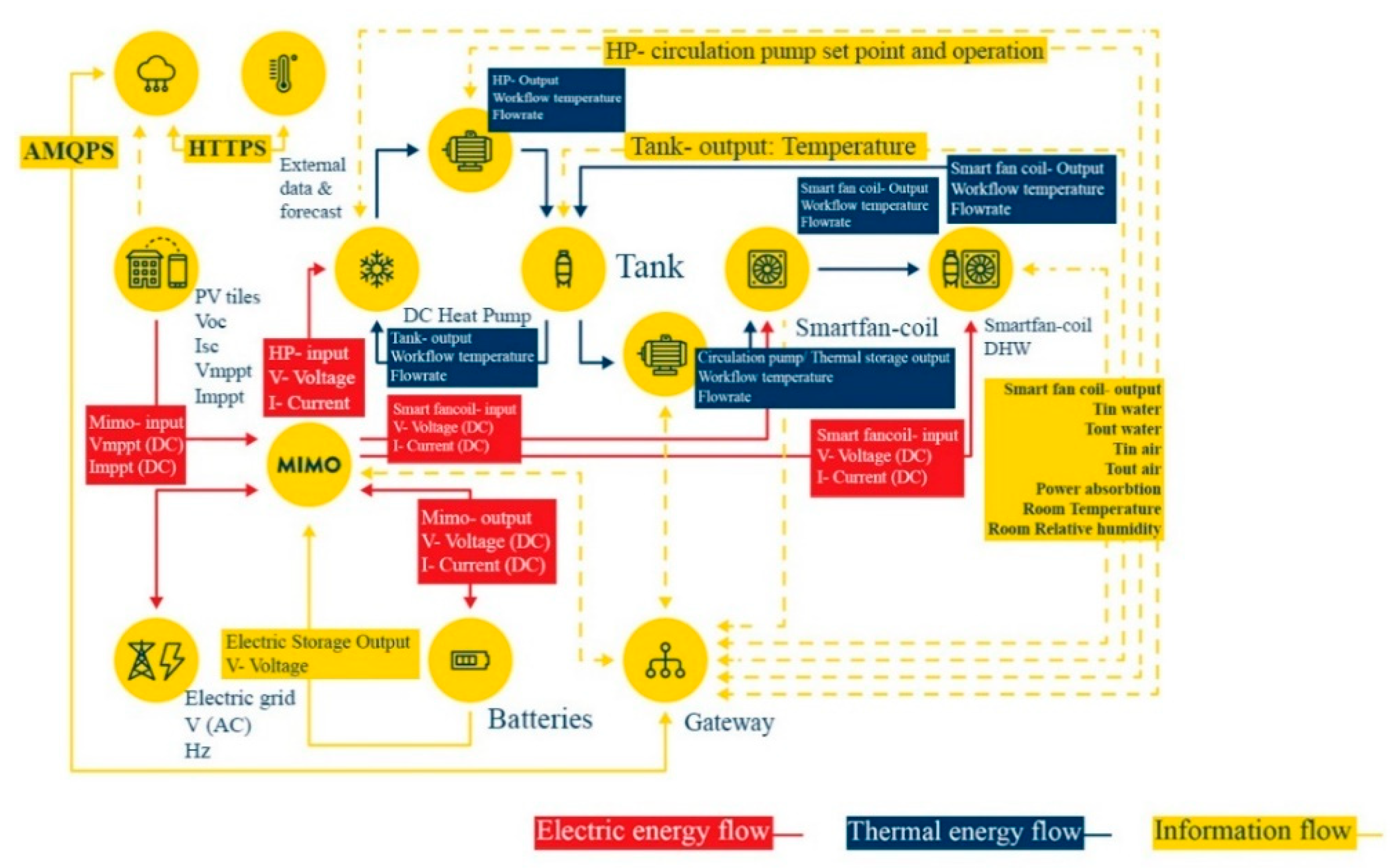
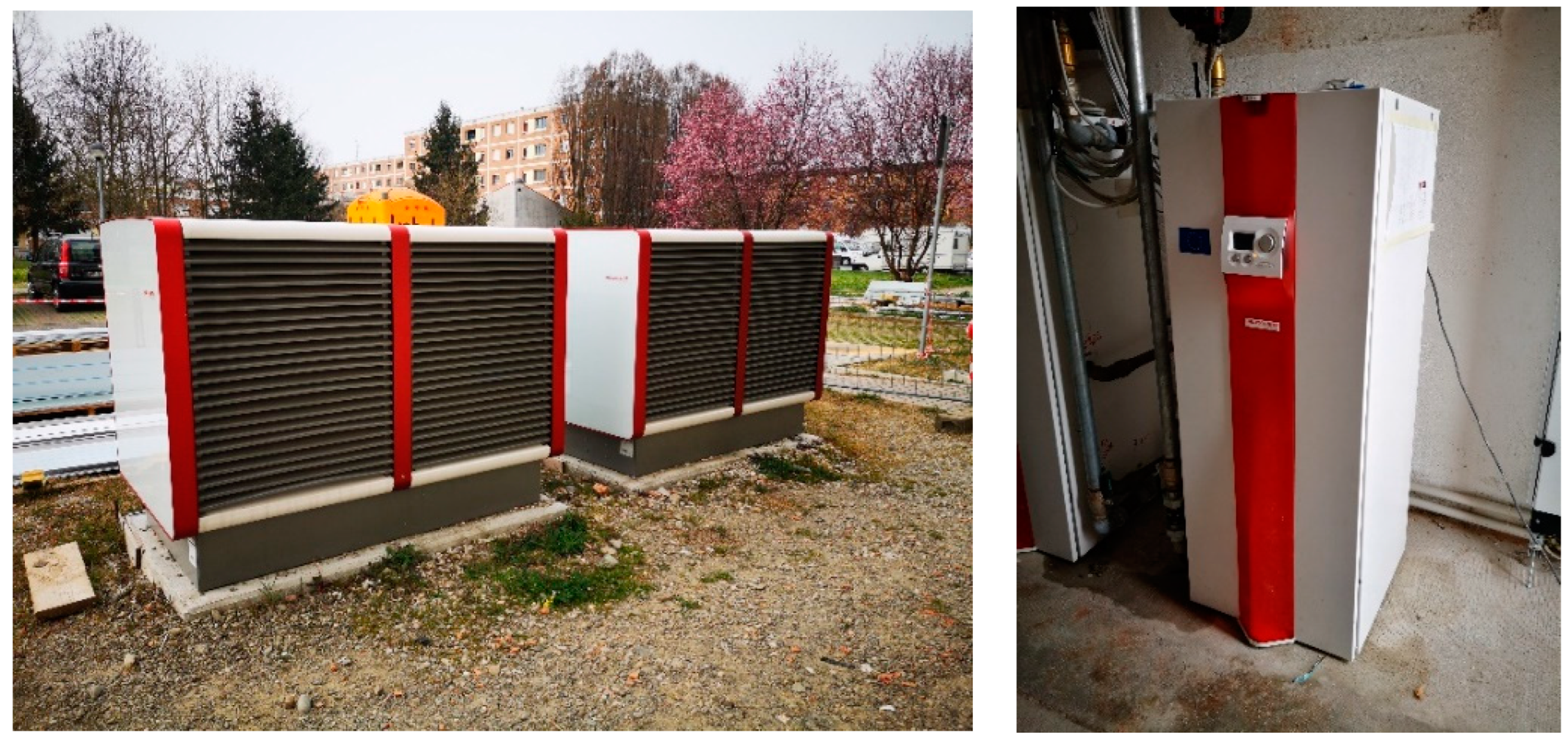
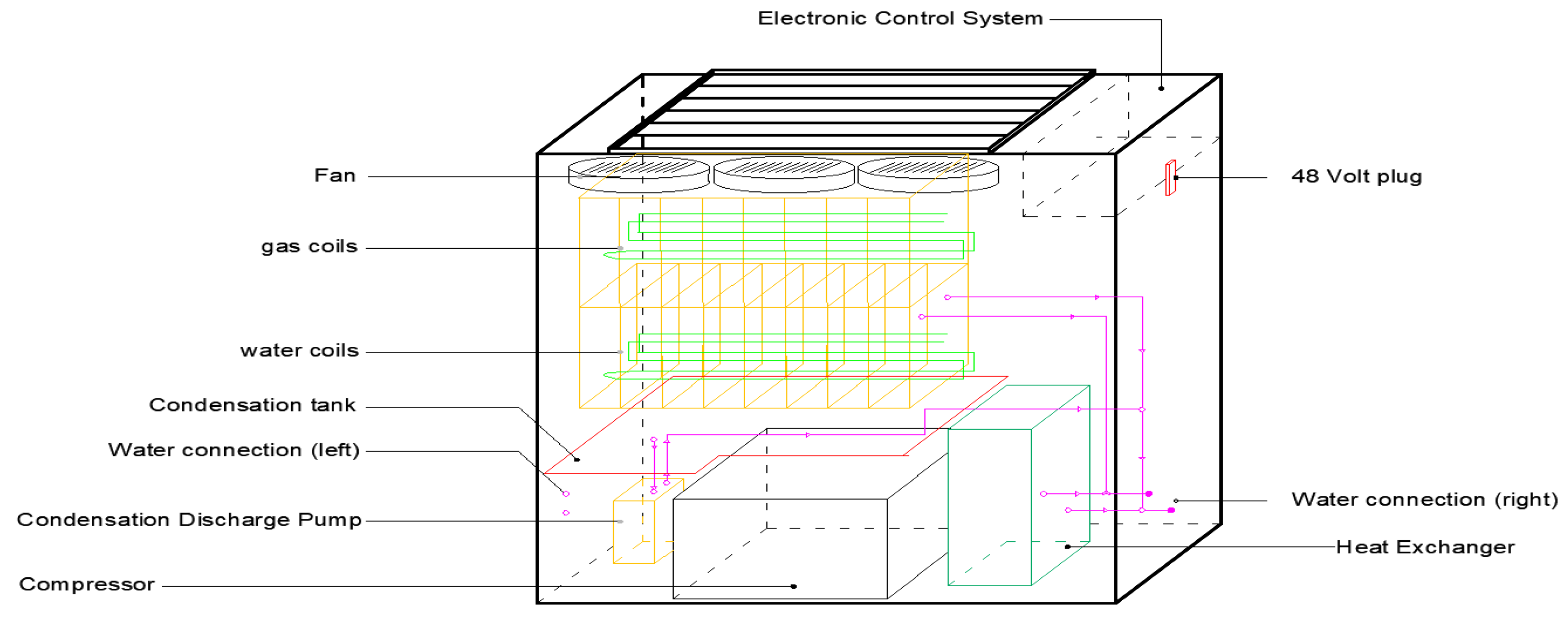
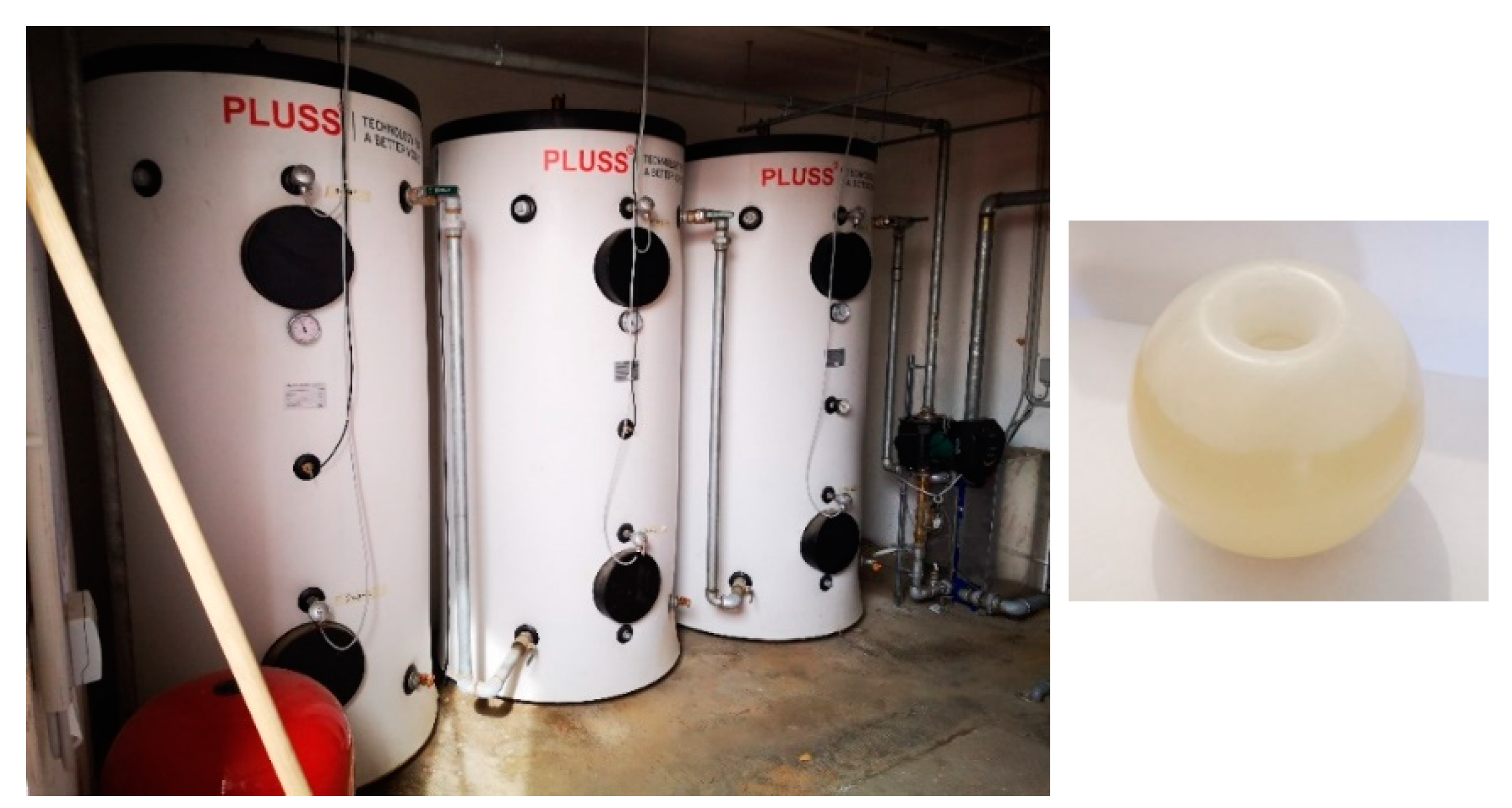


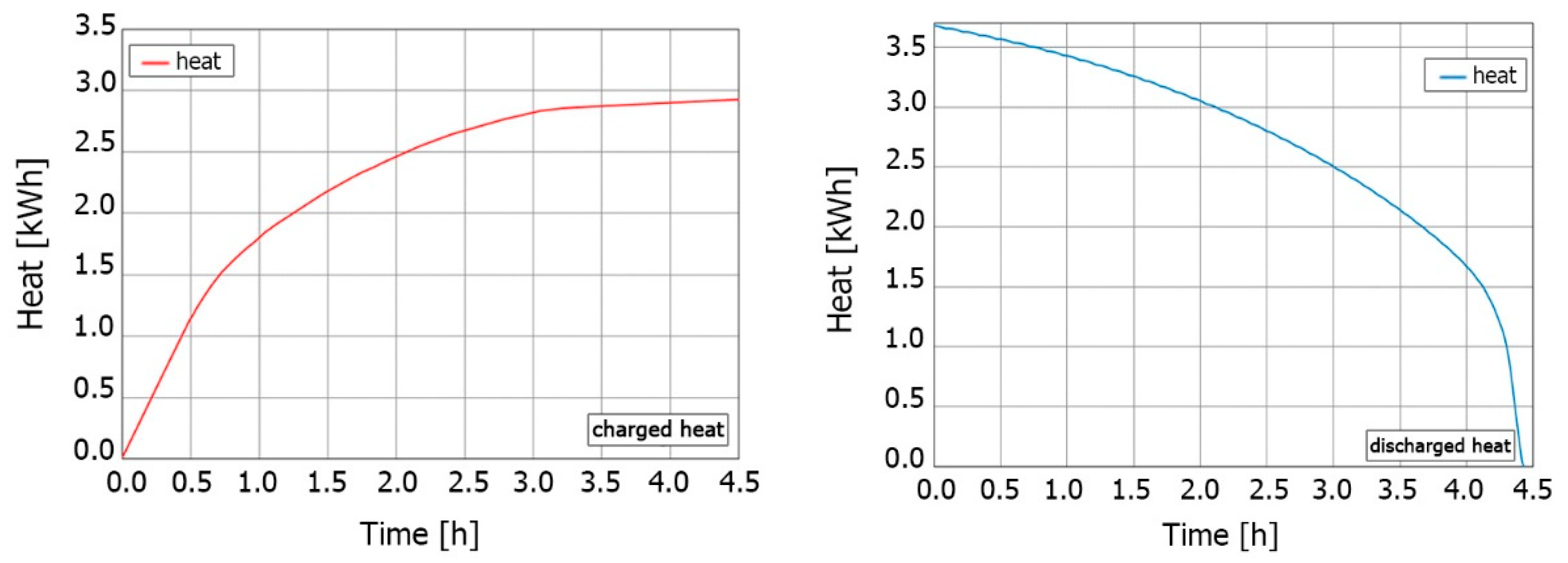

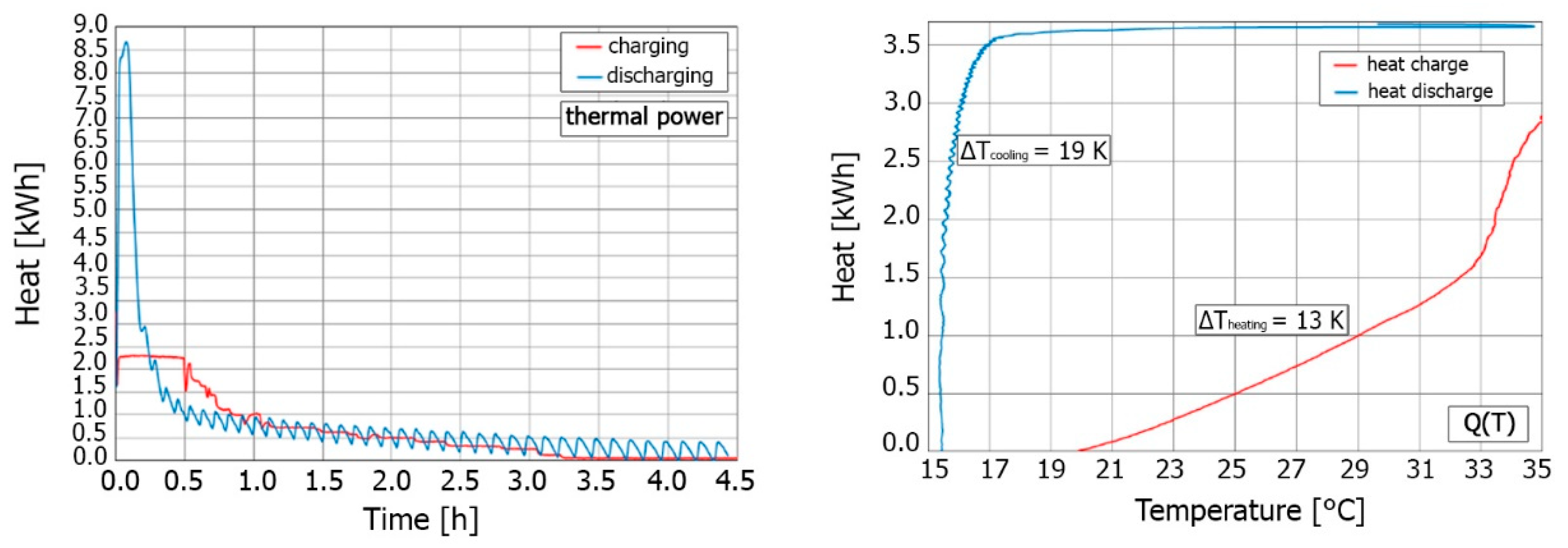
| Storage Tank (One Unit) | |
|---|---|
| Size (Ø × height) (mm): | Ø950 × 2120 mm |
| Weight (kg): | 250 kg (empty) + 425 kg (PCM modules) |
| PCM Module (One Module) | |
| Size (Ø) (mm): | Ø 75 |
| Weight (g): | 262 |
| Plastic HDPE (high-density polyethylene): | 42 g (1 empty module) |
| Salt hydrate mixture: | 220 g (in 1 module) |
| PCM Specifications | |
| Melting/solidification temperature (°C): | 26/25 |
| Specific heat (solid/liquid) (kJ/kJK): | 2.07/2.42 |
| Heat conduction (solid/liquid) (W/mK): | 1.05/0.55 |
| Density (solid/liquid) (kg/m3): | 1621/1510 |
| Enthalpy per mass (kJ/kg): | 199 |
| Enthalpy per litre (kJ/L): | 300 |
| Water capacity (litres): | 1000 (60% water + 40% PCM) |
| Maximum charge thermal power (heating mode/cooling mode) (kW): | 50/40 |
| Maximum discharge thermal power (heating mode/cooling mode) (kW): | 15 (ΔT = 35–25 °C (Treturn = 15 °C), 1 kg/s, mixing valve outlet 25 °C) |
Disclaimer/Publisher’s Note: The statements, opinions and data contained in all publications are solely those of the individual author(s) and contributor(s) and not of MDPI and/or the editor(s). MDPI and/or the editor(s) disclaim responsibility for any injury to people or property resulting from any ideas, methods, instructions or products referred to in the content. |
© 2023 by the authors. Licensee MDPI, Basel, Switzerland. This article is an open access article distributed under the terms and conditions of the Creative Commons Attribution (CC BY) license (https://creativecommons.org/licenses/by/4.0/).
Share and Cite
Osterman, E.; Del Pero, C.; Zavrl, E.; Leonforte, F.; Aste, N.; Stritih, U. Phase-Change Material Thermal Energy Storage for the Smart Retrofitting of Existing Buildings. Energies 2023, 16, 6127. https://doi.org/10.3390/en16176127
Osterman E, Del Pero C, Zavrl E, Leonforte F, Aste N, Stritih U. Phase-Change Material Thermal Energy Storage for the Smart Retrofitting of Existing Buildings. Energies. 2023; 16(17):6127. https://doi.org/10.3390/en16176127
Chicago/Turabian StyleOsterman, Eneja, Claudio Del Pero, Eva Zavrl, Fabrizio Leonforte, Niccolò Aste, and Uroš Stritih. 2023. "Phase-Change Material Thermal Energy Storage for the Smart Retrofitting of Existing Buildings" Energies 16, no. 17: 6127. https://doi.org/10.3390/en16176127





